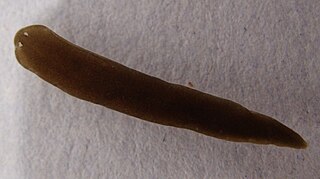
Lake Tana is the largest lake in Ethiopia and the source of the Blue Nile. Located in Amhara Region in the north-western Ethiopian Highlands, the lake is approximately 84 kilometres long and 66 kilometres wide, with a maximum depth of 15 metres, and an elevation of 1,788 metres. Lake Tana is fed by the Gilgel Abay, Reb and Gumara rivers. Its surface area ranges from 3,000 to 3,500 square kilometres, depending on season and rainfall. The lake level has been regulated since the construction of the control weir where the lake discharges into the Blue Nile. This controls the flow to the Blue Nile Falls and hydro-power station.

A planarian is one of the many flatworms of the traditional class Turbellaria. It usually describes free-living flatworms of the order Tricladida (triclads), although this common name is also used for a wide number of free-living platyhelminthes. Planaria are common to many parts of the world, living in both saltwater and freshwater ponds and rivers. Some species are terrestrial and are found under logs, in or on the soil, and on plants in humid areas.

Gorgora is a town and peninsula in northwestern Ethiopia. It is located south of Gondar on the north shore of Lake Tana, in the Semien Gondar Zone of the Amhara Region. Gorgora has a latitude and longitude of 12°14′N37°18′E.

Dugesia is a genus of dugesiid triclads that contains some common representatives of the class Turbellaria. These common flatworms are found in freshwater habitats of Africa, Eurasia, and Australia. Dugesia is best known to non-specialists because of its regeneration capacities.

Schmidtea mediterranea is a freshwater triclad that lives in southern Europe and Tunisia. It is a model for regeneration, stem cells and development of tissues such as the brain and germline.

Dugesiidae is a family of freshwater planarians distributed worldwide. The type genus is Dugesia Girard, 1850.

The Arbore are a Cushitic ethnic group living in southern Ethiopia, near Lake Chew Bahir. The Arbore people are pastoralists. With a total population of 6,850, the Abore population is divided into four villages, named: Gandareb, Kulaama, Murale, and Eegude.

Schmidtea is a genus of freshwater triclads. Species of the genus Schmidtea are widely used in regeneration and developmental studies.
Dugesia notogaea is a species of dugesiid triclad that inhabits freshwater bodies of north Queensland, Australia.
Dugesia sicula is a species of dugesiid triclad that lives in freshwater bodies of the Mediterranean Basin, where it is widely distributed. It has been reported from Sicily, Elba and Mallorca, Eivissa, Sardinia, Algeria, Tunisia, Morocco and Crete.
Girardia tigrina, known as the brown planarian or the immigrant triclad flatworm, is a species of dugesiid native to the Americas. It has been accidentally introduced into Europe and Japan.

Dugesia japonica is a species of freshwater planarian that inhabits freshwater bodies of East Asia, including Japan, Korea, Taiwan, China and northeastern Siberia. However, molecular studies suggest that Dugesia japonica is polyphyletic and different populations across its area of occurrence constitute distinct species.

Schmidtea polychroa is a species of freshwater flatworm, a dugesiid triclad that inhabits the shallow mesotrophic or eutrophic waters of rivers and lakes of Europe. It is also present in North America, where it has been introduced at least in the Saint Lawrence river system. It is an animal with a limited dispersion capability.

Dugesia artesiana is a species of dugesiid triclad found in Queensland, Australia.
Dugesia afromontana is a species of dugesiid triclad found in the Amatola Mountains, Eastern Cape, South Africa.
Dugesia hepta is a species of freshwater triclad endemic to Sardinia.

Dugesia burmaensis is a species of freshwater dugesiid found in Burma. The species was described from six individuals collected from Inle Lake, Shan State.

Cavernicola is a suborder of planarians found mostly in freshwater habitats of caves, although some species occur on the surface.
Dendrocoelum italicum is a cave-adapted freshwater planarian which is endemic to Bus del Budrio cave in the Italian Prealps.

Dugesia annandalei is a species of dugesiid planarian that is native to Myanmar. It is named after Nelson Annandale.












